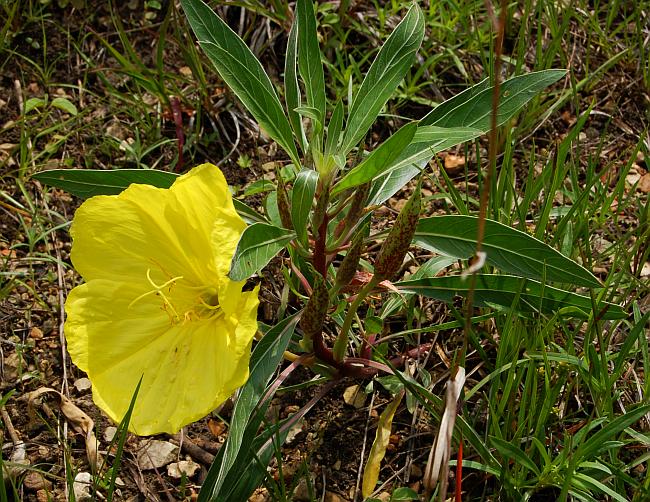Oenothera macrocarpa Nutt.
Missouri Evening Primrose

Native
CC = 7
CW = 5
MOC = 40
© SRTurner
Oenothera macrocarpa Nutt.Missouri Evening Primrose | |
 |
Native CC = 7 CW = 5 MOC = 40 |
© SRTurner |
|
Family - Onagraceae Habit - Perennial forb with a stout, woody, often somewhat branched, vertical rootstock, sometimes producing new shoots from lateral roots. Stems - Spreading to loosely ascending, one to several, to 60 cm, unbranched or with few to several branches, glabrous to densely pubescent with short, appressed, nonglandular hairs, strongly reddish-to dark purplish-tinged.
Leaves - Alternate, simple, 4-12 cm long, 4-25 mm wide, lanceolate to broadly elliptic, short-to moderately petiolate, the margins entire to somewhat irregular or wavy or with short, broad, broadly spaced teeth, hairy, the surfaces pubescent with appressed, nonglandular hairs, densely so on young leaves, often less densely so at maturity (but often grayish-tinged, as well as with reddish splotches), the secondary veins usually relatively inconspicuous.
Inflorescences - Axillary flowers, the bracts not differentiated from foliage leaves. Flowers - Actinomorphic, opening at dusk and usually remaining open into the following morning, the floral tube 95-115 mm long, pubescent with short, appressed, nonglandular hairs and minute, glandular hairs. Sepals 50-65 mm long, glabrous or with dense, appressed, nonglandular hairs, the free tips in bud 8-10 mm long, erect and appressed. Petals 55-65 mm long, 48-64 mm wide, broadly obovate, yellow to bright yellow, not fading or fading to orange. Stamens with the filaments 30-40 mm long, ascending to somewhat S-shaped or curved toward the top of the flower, glabrous at the base, the anthers 17-24 mm long, yellow. Style 55-190 mm long, the stigma deeply 4-lobed, the lobes 7-13 mm long.
Fruits - Capsules 52-75 mm long, overall broadly oblong-elliptic to oblong in outline, the main body longitudinally dehiscent, 4-locular, 50-70 mm long, 6-8 mm in diameter, narrowly ellipsoid, not flattened, strongly 4-winged, each wing 18-28 mm wide, flat to somewhat undulate, rounded or truncate at the tip, becoming tan and papery at maturity, tapered abruptly to a sterile, stalklike base 2-6 mm long. Seeds numerous in each locule, arranged in a single row, 3-5 mm long, mostly 1.8-2.3 mm wide, obovoid, the surface grayish brown to dark brown, coarsely wrinkled and usually somewhat corky. Self-incompatible.
Flowering - May - August. Habitat - Glades, bluffs, rocky prairies, quarries, roadsides, on calcareous substrates. Origin - Native to U.S. Lookalikes - None. Other info. - This is one of the most characteristic of Missouri Ozark species. The giant yellow flowers, red-speckled foliage, and curious winged fruits make it impossible to mistake for anything else. It is found in the southern half of Missouri, except for the region of the Bootheel, where it is apparently absent. It is not a particularly widespread species, with a U.S. distribution largely confined to four states (Missouri, Kansas, Oklahoma, and Texas). Photographs taken in Eminence, MO.,5-28-03 (DETenaglia); also at Shaw Nature Reserve, Franklin County, MO, 5-19-2006 and 7-1-2006, and at Valley View Glade Natural Area, Jefferson County, MO, 5-18-2010 and 5-24-2014 (SRTurner). |